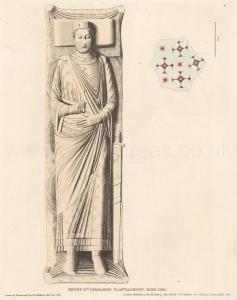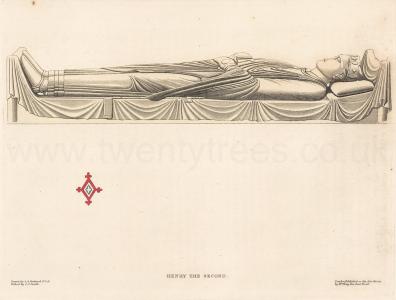Europe, France, Anjou, Chinon, Fontevraud Abbey [Map]
Fontevraud Abbey is in Chinon.
Around 05 Jun 1152 Eleanor of Aquitaine (age 30) visited Fontevraud Abbey [Map] where she met Abbess Matilda (age 41) (her husband's Henry's (age 19) aunt by marriage - Abbess Matilda (age 41) had married William Adelin brother of his mother Empress Matilda (age 50) who had died in the White Ship Disaster).

In 1173 King John "Lackland" of England (age 6) was sent to live in Fontevraud Abbey [Map] to be trained for the Church.
On 06 Jul 1189 King Henry "Curtmantle" II of England (age 56) died at Chinon Castle [Map]. William Mandeville 3rd Earl Essex Count Aumale was present. He was buried at Fontevraud Abbey [Map]. His son King Richard "Lionheart" I of England (age 31) succeeded I King England.

After 06 Jul 1189 King Henry "Curtmantle" II of England (age 56) was buried at Fontevraud Abbey [Map].
On 04 Sep 1199 Joan Plantagenet Queen Consort Sicily (age 33) died at Rouen, France [Map]. She was buried at Fontevraud Abbey [Map].
On 01 Apr 1204 Eleanor of Aquitaine Queen Consort Franks and England (age 82) died at Fontevraud Abbey [Map].
After 01 Apr 1204 Eleanor of Aquitaine Queen Consort Franks and England (age 82) was buried at Fontevraud Abbey [Map].
On 04 Jun 1246 Isabella of Angoulême Queen Consort England (age 58) died at Fontevraud Abbey [Map]. Her son Hugh Lusignan XI Count Lusignan VI Count La Marche II Count Angoulême (age 25) succeeded II Count Angoulême. Yolande Capet Countess Lusignan, La Marche and Angoulême (age 27) by marriage Countess Angoulême.

Letters. After 1279. Letter XXI. Eleanora Queen-Dowager of England (age 56) to her son Edward I (age 39).

To the most noble prince and her very dear son, Edward, by God's grace king of England, lord of Ireland, and duke of Aquitaine, Eleanora, humble nun of the order of Fontevraud [Map], of the convent of Amesbury, wishes health and her blessing.
Sweetest son, we know well how great is the desire that a mother has to see her child when she has been long away from him, and that dame Margaret de Nevile (age 24), companion of Master John Painter Giffard (age 47), has not seen for a long time past her child, who is in the keeping of dame Margaret de Weyland, and has a great desire to see him. We pray you, sweetest son, that you will command and pray the aforesaid Margaret de Weyland, that she will suffer that the mother may have the solace of her child for some time, after her desire. Dearest son, we commend you to God. Given at Amesbury [Map], the 4th day of March.
Effigy of Henry II. THE destruction of our royal effigies at Fontevraud [Map] during the Revolution had been so confidently asserted, that the known devastation of antiquities of this character in France, did not appear to be a sufficient reason to warrant the assertion; but on investigation, by every inquiry it was found to rest on no better foundation, and still wanted confirmation. As the addition of these, to commence our series appeared so desirable an acquisition, and the reflection at the same time presenting itself that by some fortunate chance they might stili be preserved, no other inducements were wanting for hazarding a journey to ascertain their fate. An indiscriminate destruction, which on every side presented itself in a track of three hundred miles, left little to hope on arriving at the Abbey of Fontevraud; but still less, when this celebrated depository of our early kings was found to be but a ruin. Contrary, however, to such an unpromising appearance, the whole of the effigies were discovered in a cellar of one of the buildings adjoining the abbey. For amidst the total annihilation of every thing that immediately surrounded them, these effigies alone were saved; not a vestige of the tomb, and chapel which contained them, remaining. Fortunately, there is nothing destroyed for us to regret. When the fury of the Revolution had ceased, it appears that the veneration these memorials of royalty had for ages excited, led to their removal from the ruined church to a place of more security. They were accordingly conveyed to an octangular isolated building, called the Tour d'Evraud, where they remained safe and undisturbed for eighteen years; but the church having been very lately converted to a prison, and this receptacle being found convenient for some purposes of the new establishment, they were again removed to their present situation, where they are subject daily to be wantonly defaced by the lowest class of prisoners, and where, if they are suffered to remain, they must soon be destroyed.
The effigies are four in number: — Henry II.; his Queen, Eleanor de Guienne; Richard I.; and Isabel d'Angouleme, the Queen of John. Considering their age, and the vicissitudes they have undergone, they are in excellent preservation. They have all been painted and gilt three or four times; and from the style of the last painting, it is probable it was executed when the effigies were removed from their original situation in the choira. It is this painting which Montfaucon has described, and it has consequently misled himb.
Our present subject, Henry II., the son of the Empress Matilda, and Geoffrey Plantagenet, Earl of Anjou, died at the Castle of Chinon [Map], nigh Fontevraud, October, 1189, in the 57th year of his age, and 35th of his reign. A modern French writer, who states as his authorities MSS. preserved in the ecclesiastical archives, says "the body of the unfortunate monarch, vested in his royal habits, the crown of gold on his head, and the sceptre in his hand, was placed on a bier richly ornamented, and borne in great state to the celebrated Abbey of Fontevraud, which he had chosen as the place of his interment, and there set in the nave of the great church, where he was buried." This account partly agrees with that given by Matthew Paris, who says, "But on the morrow, until he should be carried to be buried, he was arrayed in the royal investments, having a golden crown on the head, and gloves on the hands, boots wrought with gold on the feet, and spurs, a great ring on the finger, and a sceptre in the hand, and girt with a sword, he lay with his face uncovered." When we examine the effigy, we cannot fail of remarking that it is already described by these two accounts; the only variation being in the sword, which is not girt, but lies on the bier on the left side, with the belt twisted round it. It therefore appears, that the tomb was literally a representation of the deceased king, as if he still lay in state. Nor can we, without supposing such was the custom, otherwise account for the singular coincidences between the effigy of King John on the lid of his coffin and his body within it, when discovered a few years since.

The crown on the head of Henry II. has been probably many years broken, as appears from some remains of an injudicious attempt to restore it with plaister of Paris. It is represented without those clumsy additions in the etchings. The right hand, on which was the great ring, is also broken; but still contains a portion of the sceptre, which, if we may judge from its stays on the breast, must have been remarkably short. The character of the face is strongly marked by high cheek-bones and projecting lips and chin; the beard is painted, and penciled like a miniature, to represent its being close shaven; the mantle is fastened by a fibula on the right shoulder, its colour has been, like the cushion under the head, of a deep reddish chocolate; the dalmatic is crimson, and appears to have been starred or flowered with gold. The mantle probably was originally ornamented in a similar manner. The boots are green, ornamented with gold, on which are fastened with red leathers the gold spurs. The whole is executed in free stone, and in a style much resembling the seals of the time, but infinitely superior to what we should expect, judging by the effigy of King John, which in comparison with this is a very inferior production. We are told that Henry II. had on his tomb these lines:
Rex Henricus eram, mihi plurima Regna subegi [I was King Henry, and I subjugated many kingdoms]
Multiplicique modo, Duxque Comesque fui [In many ways, I was Duke and Count]
Cui satis ad votum non essent omnia terrae [All the earth would not be enough for him to make a wish]
Climata, terra modo sufficit octo pedum. [In the (current?) climate, only eight feet of earth is sufficient]
Qui legis hæc, pensa discrimina mortis, & in me [He who reads these things, let the judgments of death be weighed upon me]
Humanse speculum conditions habe [Have humane mirror conditions]
Sulhcit hie Tumulus, cui non sulbceret orbis. [Here lies a mound, for which the world would not mourn]
Res brevis ampla mihi, cui fuit ampla brevis. [A brief matter is ample for me, to whom it was a large brief]
Note a. By Jeanne Baptiste de Bourbon, natural daughter of Henry IV. in 1638, who at the same time erected a tomb to contain the whole of them.
Note b. For the gloves having been ignorantly painted of a flesh colour instead of white. Montfaucon says, "Je ne sai que signifient les deux marques rondes quhl a sur les deux mains. [I don't know what the two round marks mean on the hands]" Not conceiving they were the jewels on the gloves, the marks of royalty.


Margaret Blois became was a Nun at Fontevraud Abbey [Map].
Archaeologia Volume 29 Section XV. Richard having received his death wound under the walls of the castle of Chaluz in Limosin, directed that his body should be interred at Fontevrault [Map], at the foot of his father's tomb; his effigy is still preserved there, and has been accurately represented by Charles Stothard. His heart he bequeathed to the Canons of Rouen, to whom in his lifetime he had been a benefactor, and who gratefully enshrined the relic in a sumptuous receptacle, as we learn from a contemporary writer, Guillaume le Breton.
"Cujus cor Rotomagensis [Whose heart is Rouen]
Ecclesie clerus argento clausit et auro, [The clergy closed the church with silver and gold]
Sanctorumque inter sacra corpora, in æde sacratâ [And among the sacred bodies of the saints, in the sacred meal]
Compositum, nimio devotus honorat honore; [The compound, the most devout, honors with honor]
Ut tante ecclesia devotio tanta patenter [So much devotion to the church so openly]
Innuat in vita quantum dilexerit illum." [He hints in life how much he loves him] Putipripos, Lib. v.